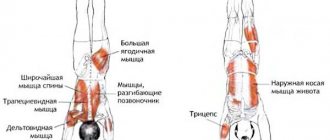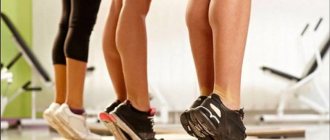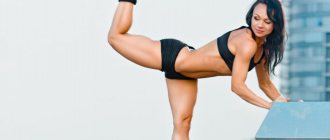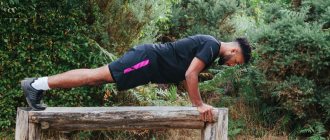Headstand. Why and for what
Daily practice of headstand for at least 3-5 minutes heals the body on several levels:
- stimulates brain function due to blood flow;
- normalizes the activity of the hypothalamus and pituitary gland;
- relieves anxiety;
- improves vision, attention and concentration;
- reduces stress on the heart;
- redistributes blood in the body;
- speeds up metabolism;
- promotes weight loss.
Headstand is the queen of asanas due to its benefits and healing properties.
Sometimes breathing exercises and practices are added to the headstand. They increase the supply of oxygen to the blood, which improves memory and concentration.
Recommendations for performing a headstand
For beginners to practice Shirshasana, at first it is recommended to stand on your head, pushing off the floor with your feet and making a small swing with one leg. In this case, the second leg must first be raised up. But when the arms and back themselves begin to “pull up” the entire lower body, the need to swing will disappear by itself.
And also the most convenient and safe place to practice Shirsasana is the corner of the room. You need to stand diagonally so that, if necessary, your feet have support in the form of a wall.
An important detail should be taken into account - you cannot lean on the wall, otherwise in the future you will not be able to exercise the stand without additional support. If you feel a sense of balance, you can try to get into Shirshasana without a wall at all. If you suddenly lose your balance and there is no support nearby, you need to fall on your back, grouping your body into a “somersault” pose, which will be the result.
A passive version of the Shirsasana stance is to perform it with straps or a rope. The advantage here is obvious: this technique allows you to increase the duration of execution, which, in turn, will allow you to get rid of the deepest tensions, speed up the regeneration process and restore the energy charge of the body. This option is especially beneficial for people struggling with asthma and bronchial problems.
The advantage of Shirshasana with straps is the passive form of the exercise, which provides deep relaxation and elimination of pockets of hidden tension.
The benefits of the headstand are ideal:
- for those suffering from asthma and bronchial problems;
- from neck and shoulder tension;
- to slow down the aging process.
The duration of stay in the position can be slightly increased: from 3-5 to 20 minutes, and always under the guidance of a certified yoga teacher.
Attention! It is necessary to leave the stance immediately if there is a feeling of increased pressure in the ears, eyes, or head.
Benefits of headstand
Exercise benefits the spine and the entire body as a whole. At first, the body experiences stress from the unnatural inverted position, but this state is useful because... activates metabolic processes in the body.
Relieves swelling . Regularly performing handstands or headstands helps relieve swelling. This is due to the redistribution of blood and lymph throughout the body, due to which the swelling gradually disappears.
Rejuvenates the body . Activating blood flow to the face improves complexion, tightens the skin and fights wrinkles. Increased blood flow to the brain has a positive effect on the functioning of the hypothalamus. It better regulates the functioning of the thyroid and adrenal glands.
Prevention of varicose veins . The stand is useful for varicose veins and an increased risk of dilation of venous vessels, because When performing the asana, venous outflow from the lower extremities to the head improves.
Has a positive effect on visual acuity . Performing a stance has a positive effect on visual acuity. Blood flow improves nutrition of the organ of vision. Stagnation in the retina passes, and vision gradually improves.
Improves the functioning of the digestive system . A person who regularly performs the asana improves digestion and relieves constipation.
Promotes conception . Women's reproductive function improves, thereby increasing the likelihood of pregnancy.
Acceleration of hair growth . The stand improves hair nutrition, the rush of blood to the head promotes more active growth. Some women manage to achieve full and beautiful hair by doing yoga exercises.
Benefits for the cardiovascular system . Due to the inverted position of the body, blood flows away from the heart. It “reboots” and starts working correctly. In humans, blood clots and cholesterol plaques dissolve.
Yoga experts point out that asana redistributes the flow of internal energy. A person’s chakras open, and the body begins to work harmoniously
Headstand: benefits
Headstand in Sanskrit is called Shirshasana (शीर्ष śīrṣa - 'head', आसन āsana - 'body position').
It refers to inverted asanas, when the body is completely inverted in a vertical position. The health benefits of headstand are undeniable, but only if you do it as correctly and safely as possible. Headstand
is one of the inversion poses that are known for their beneficial effects on the body. Let's consider what effects we can get from performing Shirshasana.
- Like all inverted poses, headstand
reverses all physiological and energetic processes, which is why it is believed to slow down the aging process. - There is a flow of blood to the head, which improves cerebral circulation and increases the supply of nutrients to the brain. Sirsasana helps strengthen blood vessels in the brain and can prevent headaches and migraines. It is also believed that headstand
can help slow down the process of hair loss and the appearance of gray hair on the head. - It has a beneficial effect on the cardiovascular system, reducing heart rate and blood pressure, increasing the flow of venous blood to the heart and cardiac output, as well as the lymphatic system, which, in turn, helps remove toxins from the body.
- It is also believed that blood flow to the head has a beneficial effect on the blood vessels of the eyes.
- Increases muscle endurance.
- Improves digestion.
- The vessels of the legs rest, which allows you to get rid of congestion in the lower part of the body. Swelling in the legs decreases. Headstand
is useful for varicose veins. - Improves blood circulation and circulation throughout the body. It has a beneficial effect on the functioning of the nervous, circulatory, respiratory, reproductive and endocrine systems.
- Stimulates the pineal gland and pituitary gland, responsible for growth and development, helps in the fight against diabetes.
- Headstand
increases parasympathetic tone, calms, helps relieve stress and nervous tension, anxiety, actively affecting the adrenal glands.
Headstand technique
The asana must be performed correctly and according to the recommendations of a doctor or instructor to avoid injuries and falls. Before shirshasana, it is advised to rest in the baby pose, which stabilizes blood pressure.
There are several options for making a rack:
There are different options for implementation, so both beginners and experienced people will be able to choose the right technique for themselves. If you are just starting to master a headstand, then it is better to practice against a wall, but only to insure your support in case of a fall.
- If you want to hold the pose for a long time, distribute 80% of the weight on your head and 20% on your hands. The abs and back muscles need to be involved in the work as much as possible, controlling and keeping the muscles toned.
- To strengthen your abs and reduce stress on your back, distribute 20% of your weight on your head and 80% on your arms. The abs are involved in the work to a greater extent than the back. This is the safest training method for beginners. It is advisable to hold this position for about 30 seconds.
- Even distribution between the arms and head can cause head and neck injuries. Due to the fact that the body weight can go behind the head, it is very difficult to maintain the correct posture. This option is best not practiced due to the high risk of injury.
Visual instructions for performing a headstand
One of the common mistakes is the wrong point of support: together with the top of the head, the entire load is distributed on the forehead area. Be sure to learn how to correctly adjust your posture and head position.
You need to perform the stand before eating or on an empty stomach. It is recommended to warm up the body with the help of the Surya Namaskar complex.
Preparing for a headstand
Shirshasana is not an easy asana. How to do an elbow stand? This process takes some time and requires preparation, which should be step-by-step:
Stage 1. While lying on your back, lift your head from the surface 1-2 centimeters and try to hold it that way longer. This strengthens the neck. The ultimate goal is to hold the pose for 2-3 minutes.
Stage 2. Learn to perform inverted asanas: downward-facing dog, birch tree.
Stage 3. Gradually performing a headstand:
- Practice kneeling for a week (lower your head on the surface, hands behind your back) and move to position No.5.
- Perform position No. 6 for a week.
- After this, try to perform Shirshasana.
Step-by-step execution of a headstand
- Interlace your fingers at the top of your head, spread your elbows to the sides.
- Lean forward and lower your head and forearms to the floor in the same position. The neck is extended, the shoulders stretch upward towards the pelvis.
- Straighten your knees, place your toes on the floor, and come as close to your arms and head as possible so that your tailbone and pelvis are above the top of your head.
- The spine is elongated. When you get as close as possible and feel that the body weight is on your forearms, lift your leg off the floor and pull your bent leg towards your chest. Do not make a strong smell, otherwise the body may be pulled back by inertia and the body weight will be distributed incorrectly. Press the knee of the leg that participated in the push-off to the chest and slowly straighten it without losing balance.
- Take your time to straighten both legs until you feel confident in the position.
- Slowly move your legs up until your head, pelvis and legs form a straight line. Make sure that there is no arching in the lower back; to do this, tuck your tailbone forward.
The pose must be held for at least half a minute. You cannot leave the pose abruptly. Come out as gradually as when building up the pose.
Correct technique for performing a headstand
Before performing Shirshasana, it is important to adequately assess the capabilities and preparedness of your body so as not to cause harm to it. This stance is considered complex in its technique and requires the presence of well-developed muscles of the cervical region, shoulders and arms. It is also important to stretch your muscles before performing the exercise to prevent possible injuries and damage. Let us examine step by step the basic principles of the technique of performing the Shirsasana stance:
How long should you stand on your head?
You should never try to hold your body in a headstand for as long as possible: this will no longer be beneficial, but it can cause harm to the body. You should determine for yourself the period of time during which you can easily maintain balance and be in the asana without tension. In addition, you need to learn how to exit the stance correctly.
Standing head position
Let us remind you that you need to move on to this stage of the exercise if you have a confident and comfortable feeling in the previous steps of preparing for the stand.
You need to determine the optimal place where your head should rest. This is quite simple to do: take a book and place it on your head at an angle of 90 degrees. The point where the book and head touch will be the individual optimal place of support.
How to get out of a headstand correctly
Coming out of the stance is the most important element of the exercise, because if you make a mistake at this stage, you can get seriously injured. Some people simply “drop” their feet on the ground: this is not worth doing. You need to exit the stance just as slowly as you enter it. Be sure to smoothly lower your feet to the ground while doing breathing cycles.
Precautionary measures
Standing on your head, even for a few seconds, is not for everyone. There are contraindications to performing this stance:
- cardiac ischemia;
- eye diseases - conjunctivitis, cataracts, glaucoma;
- thrombosis;
- atherosclerosis;
- otitis;
- tendency to nosebleeds;
- osteochondrosis, vertebral displacement, intervertebral hernia.
People with spinal problems should not train. When performing the exercise, precautions must be taken. Without proper physical training, standing on your head is prohibited: due to lack of training, you can damage the cervical vertebrae or even break the spine. There is no need to strain your neck if you have a migraine or severe fatigue.
Perform a headstand only if you have no obvious contraindications and you feel well
Who should not do a headstand?
Since during headstand the Sirsasana (headstand) technique alters head/ neck loading: Considerations for safety the load is 40–48% of body weight, it cannot be performed if there are any problems with the cervical spine. Also, you should not Medical and physiological aspects of headstand do a headstand under the following conditions:
- period;
- complications in the first trimester of pregnancy;
- second and third trimesters of pregnancy;
- high myopia, problems with the retina;
- high blood pressure;
- ear infections;
- Meniere's syndrome;
- concussions and their consequences.
Preparation
When preparing for a headstand, it is recommended to perform several basic yoga asanas to stretch and strengthen the neck muscles, arms, forearms and back.
Adho Mukha Svanasana - Downward Facing Dog
Stretch your back straight, without lifting your legs and arms from the floor. There should be an angle of 60° between the retracted stomach and hips, and the heels should be pressed firmly to the floor. The position should look like the letter "L". You need to stay in this position for some time. Breathe calmly. At this time, you can evaluate the correctness of the position:
- The arms and back are in line, the forearms tend inward and the shoulders outward.
- Spread your fingers wide, distribute the weight evenly on the pads.
- The head is between the shoulders, continues the line of the back and arms, the neck is relaxed.
- The tailbone tends upward, try to straighten and lengthen the back muscles.
- The feet should ideally be pressed firmly to the floor.
You should remain in this position for 5 breathing cycles.
Setu Bandha Sarvangasana - Bridge Pose
It is also recommended to master the “bridge” exercise. It promotes the development of flexibility, strengthening the muscles of the shoulder area, arms and back. At first, it is allowed to stand from a lying position, pushing off the floor, and later you should move on to performing it from a standing position.
- Lie on the floor, bend your knees, place your feet as close to your buttocks as possible. The feet are parallel to each other, the toes point forward. Hands lie along the body, palms down.
- As you exhale, pull your tailbone in and push your pelvis up. Hips and knees should be parallel to each other.
- The entire front of the thighs should be extended. Raise your pelvis until your thighs are parallel to the floor.
- Leaning on your shoulders, place your hands under your buttocks, clasp them together and extend them towards your feet. The neck should not be tense, the weight should be distributed on the shoulders. Expand your shoulder blades and raise the space between them.
- Stay in this position for about 1 minute.
The bridge strengthens the muscles of the back and lower back and develops flexibility.
Savasana - corpse pose
During the pose, you are allowed to doze for a short time. When exiting, you need to stretch out your hands, slowly move them under the back of your head, and cross your phalanges. Stretch your heels forward. Then you need to stretch left and right and slowly sit down.
- Lie on the floor, close your eyes, place your arms freely, relax your shoulders, palms should look up.
- Relax your legs, let your feet lie to the sides.
- Relax completely and perform 20 breathing cycles, feeling how your body expands.
- After completing the exercise, exhale and lie on your right side, pressing your knees to your chest.
- Open your eyes and slowly rise, helping yourself with your hands.
Before standing on your head, you should strengthen your arm muscles with push-ups and pull-ups. The plank exercise is useful. To do this, your arms are shoulder-width apart, your hands pointing forward. The emphasis is placed on the palms, arms extended. The body forms a straight line, the back is also straight. The lower back should not bend.
How to do a headstand
Kneel on the floor and lower your pelvis onto your heels. Place your elbows shoulder-width apart, press your forearms to the floor and interlock your fingers so that your hands resemble the letter V. Place your head on the floor at the top of your head, pressing your hands to the back of your head.
Push your pelvis up and bring your body to a vertical position. The head, neck, body and pelvis should be on the same line. If necessary, take a couple of small steps on your toes to get into the correct position.
Bend your knees one at a time and pull them toward your chest. Tighten your abs and smoothly extend both legs up.
Exiting a pose copies entering it, but in reverse order. Bend your knees first, then your hips, place your toes on the floor and return to the starting position sitting on your heels.
If you can't lift your legs because you're afraid of falling on your back, try standing next to a wall first. Just don’t press yourself against the surface, but position yourself one step away from it. This way you can overcome fear, but at the same time you will not lean against the wall, giving your body a chance to stabilize on its own.
Errors when performing a stance
It is important for beginners to learn how to correctly enter a headstand from the first attempts, so that the body gets used to the correct sensations. Once you get used to the correct entry, you won’t have to retrain your body if the technique is incorrect.
Most beginners make mistakes that prevent them from taking the desired pose:
- If the muscles in your legs and back are completely relaxed while performing the exercise, you will not be able to keep your body straight and may get injured. Therefore, it is important to constantly monitor body movement.
- Failure to maintain a straight position of the spine and buttocks. They should form a straight line, without bending. If you do not follow the rule, there is a high probability of falling and injury.
Common mistakes when performing a headstand
It is important to remember one rule: you need to especially carefully monitor your sensations in the neck area, since this is the part of the body that is most easily injured. The main support should be on the head, and not on the fontanel. You also need to pay special attention to the position of your elbows and legs: if they are spaced too wide or, conversely, too narrow, it will be quite difficult to maintain balance. It is also necessary to take into account that when performing a headstand, the muscular corset takes on a large load, so it is so important to warm up the muscles before starting the exercise itself.
Recommendations from professionals
The asana should be performed slowly, calmly and measuredly. Sudden movements are completely excluded. According to experts, it is important to adhere to several rules:
- Kneel down, lower your forearms in front of you. Interlace your fingers. Place the crown of your head in these intertwined fingers.
- Place your feet on your toes and get into dolphin pose.
- Bend your left leg, extend your right leg, lifting it up in one fell swoop.
- Slowly raise your left leg.
Completing step 3 involves some difficulties: it does not always work out the first time. It is recommended to make gentle bouncing movements (at first a person can repeat them even up to 20 times). Weight should not be placed on the head to avoid injury. Finding the center of gravity can be difficult - having done this, you need to tense your abdominal muscles and use them to lift your legs.
It is not recommended to master the asana technique on your own at home for the first time. It is better to train with an instructor or at least a person who can give you advice and has experience in yoga.
Variations of Sirsasana
During the preparatory period, you can do Sarvangasan pose - shoulder stand or birch, as taught in physical education in childhood.
In Sarvangasana, the body weight and load should be on the elbows and shoulders, and only a little on the head. Your neck will remain safe and sound if you strictly follow two rules while performing Sarvangasana - do not twist your head and enter the pose extremely carefully. Several folded blankets for support under the shoulders will help maintain the natural curve of the neck and avoid straining the neck muscles.
- Place your shoulders on the blanket, head on the floor;
- Make sure there is space between the curve of your neck and the floor, inhale and lift your legs and lower back up using your abs so that they form a straight line with your back.
- Use your hands to support your back and upright position.
Shoulderstand is one of the important and fundamental asanas in yoga.
Beginners can remain in the pose for 10-30 seconds, gradually increasing the time. Listen carefully to all sensations; if even the slightest discomfort appears, further performance of the pose should be stopped.
There are 2 options for the asana:
- Salamba is the handstand and headstand we talked about in this article;
- Niralamba is a hands-free stance. Requires much more time and physical preparation. The asana is performed only when you have achieved perfection in a headstand with the help of your hands and forearms and confidently hold yourself upside down.
Headstand: contraindications
It is very important before performing any inverted asanas, and especially headstands, to familiarize yourself with the contraindications. You should not rush to master this asana if you have:
- problems with the neck and spine (protrusions, displacement of the vertebrae, pathologies of the cervical spine);
- there were traumatic brain injuries;
- arm and shoulder injuries;
- increased intracranial pressure, headache;
- high or low blood pressure (hypertension/hypotension);
- heart disease and heart failure;
- sinusitis;
- increased intraocular pressure, weak eye vessels;
- insomnia;
- pregnancy and menstruation (in women);
- postoperative period, also during recovery from injuries, refrain from performing a headstand.
If you find contraindications to performing a headstand, do not be discouraged, you can choose alternative inversions that will allow you to get the same positive effects, but with less risk to your health.
Headstand in yoga: how it can harm
If you decide to master the headstand, then first you need to familiarize yourself not only with the contraindications, but also with the important nuances of the technique of performing Shirshasana, so as not to harm your body.
If headstand
will be performed incorrectly, this can lead to injury, so follow the basic rules of injury prevention when performing Shirsasana. First, let's look at which muscles of the body are actively involved in performing a headstand and which asanas will help work them out in order to prepare the body for performing Shirsasana. Firstly, the abdominal muscles. If you have weak abdominals, then you will likely have difficulty mastering Shirshasana, since it is due to the activation of these muscles that the legs are lifted up. To strengthen the abdominal muscles, you can practice Paripurna Navasana and Ardha Navasana. Secondly, the hamstrings. Tight hamstrings can be a barrier to mastering the headstand. How easily you can perform forward bends, such as Uttanasana, with the ability to lower your hands to the floor, indicates whether you are ready to master Shirshasana. Thirdly, you must have fairly strong back muscles and a flexible spine. Shalabhasana or Bhujangasana will help strengthen the back muscles; dynamic vinyasas with alternating bends and bends will ensure flexibility of the spine. Fourthly, developed shoulder joints and strong arm muscles will allow you to confidently hold your body weight in this position. Perform all asanas where your arms are actively involved: arm balances, Chaturanga Dandasana, Vasishthasana.
Use quick tips on how to do a headstand
as safe as possible.
- When you lift your legs up, focus on placing your body weight on your arms and not on your head.
- If you feel like you might fall forward, tuck your chin towards your chest, this will allow you to avoid neck injuries.
- It is possible to injure your neck when performing a headstand because it is not designed to support the weight of your entire body. If performed incorrectly, it can lead to neck deformation or herniated intervertebral discs. Stretch your neck away from your ears: it should not be pinched, but straightened.
Contraindications for Shirsasana
During the stance, blood rushes to the head, so people suffering from nervous system disorders are better off not starting to perform asanas.
Other contraindications for the practice of Shirsasana:
- cardiac and vascular pathologies;
- rehabilitation period after a heart attack or stroke;
- colds accompanied by elevated body temperature.
Standing on your head is prohibited during pregnancy or menstruation.
When performing a stance, blood pressure increases. In this regard, people suffering from high blood pressure should be careful. They feel stunned for a while. After returning to the natural position of the body, the sensation gradually passes.
Positives of the headstand
- The heart muscle is unloaded, the body rests, and the vascular system is strengthened.
- If you take deep breaths while doing the exercise, you will help saturate the blood with oxygen and improve the functioning of the brain center.
- If you stand on your head correctly, without using the back muscles, tension in the lower part of the spine will be relieved and the flexibility of the vertebrae will improve.
- This exercise allows you to be kind and inspired all day long, recharge yourself with positive thinking, and get rid of negative thoughts.
This pose heals and rejuvenates the entire body. Helps normalize the functioning of the digestive tract, improves the metabolic process, and relieves mental and physical fatigue.
Memo
- Daily practice of headstand for at least 3-5 minutes heals the body on several levels.
- Exercise benefits the spine and the entire body as a whole. At first, the body experiences stress from the unnatural inverted position, but this state is useful because... activates metabolic processes in the body.
- Yoga experts point out that asana redistributes the flow of internal energy. A person’s chakras open, and the body begins to work harmoniously
- The asana must be performed correctly and according to the recommendations of a doctor or instructor to avoid injuries and falls.
- Perform a headstand only if you have no obvious contraindications and you feel well
For a confident headstand, basic physical training is required. We have put together a selection of training complexes for you that will help keep your whole body in good shape. Enter your email and click the download button ↓
What does a headstand do?
We have looked at the benefits of a headstand in terms of its physiological effects, now let’s talk about what a headstand does from an energetic point of view.
Headstand
raises energy to higher centers and transfers consciousness to a higher level. Thus preparing for meditative practices, improving concentration, bringing attention inward, clarifying the mind and calming mental noise. However, we should not forget that the practice of asanas alone cannot achieve higher states of consciousness. You can stand on your head for a long time every day, but no enlightenment or insight will ever come to you, because yoga is a multifaceted system of self-development, which includes many tools for the development of consciousness. Remember that asanas are only a small part of this system.











